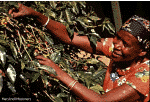 World Hungry
World Hungry
Hungry problem is throughout the world. At least a half
million people are hungry every day. In 1980, fifty-three
developing countries did not have enough food. More than
twenty African countries have very serious food problems.
There are also hungry people in developed countries.
What
causes world hunger
1. Geography.
Only about ten percent of the earth's land is good for
agriculture. Another twenty percent is good for raising
animals.
2. Climate.
Sometimes the weather is too hot, too cold, too wet, or too
dry. Sometimes there are storms, and floods. The weather can
destroy all the crops in an area.
3. Destruction of crops.
Insects, rats, and other animals eat from one fifth to one
third of all the crops in developing countries.
4. Transportation.
Sometimes there is extra food in one part of a country, but
there is no way to take it to another part of the country.
There are not enough trucks and trains. Developed countries
give food to poorer countries, but sometimes there is no way
to transport it to the villages.
5. Education.
 Villagers need to learn the new
ways of farming. They cannot grow enough food when they use
old methods. Developing countries need to do research to find
solutions to their agricultural problems, but they do not have
enough specialists.
Villagers need to learn the new
ways of farming. They cannot grow enough food when they use
old methods. Developing countries need to do research to find
solutions to their agricultural problems, but they do not have
enough specialists.
6. Choice of crops.
Some poor countries use most of their land to grow just one or
two for export. They do not have enough extra land to grow
food for the people. If there is bad weather or a plant
disease, the crop is destroyed. Then there is no money from
the exports to import food.
7. Customs.
Sometimes an area can grow a new kind of food, but the people
want to eat the kind of food they are used to. If they always
eat rice, they don't want to eat corn. If they are used to
beans, they don't want to eat peanuts.
These are not simple problems. They are very complicated. One
problem causes another problem. The solution to one problem
causes a new problem. Some powerful people don't want to solve
these problems. As long as they have a lot of money, they are
happy. Meanwhile, people are hungry.
Weather and climate
Weather and climate are often confused. Both characterize
the troposphere-the part of the atmosphere nearest the surface
of the earth. But weather is a short-term event, like a frame
of film, whereas climate is more like a movie. Climate is a
generalized description based on the weather conditions of a
place over a long period of time. The primary features of the
air that determine weather are temperature, moisture content,
pressure, and currents, or winds. These four elements are
affected and“controlled”by other factors, such as the pattern
of distribution of land and water; the topography of the land
and the presence of landform barriers; ocean currents;
latitude, or the position of a place between Equator and pole;
and the activities of people.